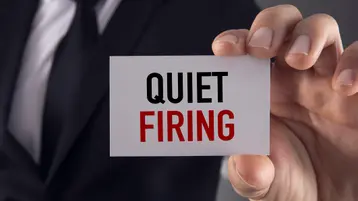
Table of contents
- 1."Quiet firing" vs. "quiet quitting"
- 2.Quiet firing
- 3."Quiet quitting"
- 4."Quiet" consequences
- 5.Firing without cause
- 6.Quitting drawbacks
- 7.The takeaway about quiet firing and quiet quitting
- 8.Comply with the law
- 9.Focus on engagement
"Quiet firing" vs. "quiet quitting"
So, why are two old workplace maneuvers getting so much heat right now? Is "quiet quitting" a response to "quiet firing" and vice versa? And why the secrecy? Wouldn't it be easier for employers to terminate unwanted workers and for unhappy workers to quit a job they don't like? Answering these questions isn't simple once it's clear how each tactic works and why.Quiet firing
"Quiet firing" occurs when employers use subtle tactics to get unwanted employees to leave the company instead of firing them outright. The goal is to make work so unbearable and the work environment so toxic that these employees will eventually leave on their own.Managers who engage in quiet firing try to isolate employees in various ways.Managers who engage in quiet firing try to isolate employees in various ways, such as:
- Refusing to give feedback on their performance.
- Excluding them from important meetings.
- Piling on their workloads.
- Passing them over for raises, promotions, and favorable assignments.
- Denying them training and other opportunities for career development.
"Quiet quitting"
Employees who engage in "quiet quitting" choose to cut back on the amount of work they do. But unlike managers who simply want an employee to quit, the team members have different reasons for cutting back their work. In a company blog shared with Workest, Kamela Lupino, director of Culture & Engagement Practice at Kincentric, wrote that "quiet quitting" is neither "quiet" nor necessarily about "quitting." That is, employees may be upfront about changing how they perform their job but not yet ready to leave. Lupino also said that quiet quitting isn't one experience with a single root cause but two employee experiences instead. Here's how she explained the breakdown:- Employees are energized but not necessarily about what's happening at work. Due to the pandemic, many realized there's more to life than a job. So, they work within their scheduled hours and not a minute more, stop going the "extra mile" for a promotion, or do just the amount of work that's required.
- Employees are tired, mostly from what's happening at work but also because of other factors. A Talent Uprising (which Lupino said is a more accurate description of shifts in the workforce than the Great Resignation) causes staff shortages, leaving remaining employees feeling overworked with no increase in pay and tired from continuously answering employee surveys that don't result in any changes in their work conditions.
"Quiet" consequences
Quiet firing and quitting probably wouldn't create so much buzz if they didn't involve some controversy. But engaging in these behaviors can backfire. Quiet firing may be a cost-effective way of firing someone, but it also can have negative outcomes. "The example it gives the rest of the team, the lack of certainty about the outcome, the potential contagiousness to other employees, and the demotivation it can generate can be very damaging, "said Raymond. "Most of all, the behavior is clearly not the most respectful way and raises moral and ethical questions."Firing without cause
Does quiet firing ever have an upside? Titterington said that while quiet firing may seem like a disgusting thing for managers to do to employees, it can be a reasonably safe and legal way to eliminate problematic employees. "W2 employees can be hard to fire, especially without a concrete cause. But sometimes a person just isn't a good fit for the work or the company culture," said Titterington. "Quiet firing provides a way for these workers to weed themselves out, so to speak. Handling something passively is not the healthiest practice. In some cases can even seem abusive to the worker, but it is effective in many cases." Yourdictionary.com refers to quiet firing as another term for "constructive dismissal." In turn, constructive dismissal is a modification of the term "wrongful termination," an action that a court could rule as illegal. Since employees who believe they were wrongfully discharged could sue an employer, managers who engage in quiet firing must make sure they can justify their actions. They must also ensure they're not discriminating against employees violating the 1964 Civil Rights Act.Quiet firing as another term for "constructive dismissal."Some of the consequences of quiet firing that could violate this section of the law include:
- Growing resentment among employees
- Fostering low morale and increasing turnover rates
- Creating a slump in productivity, often caused by denying employees recognition or not motivating them.
- Attracting fewer new applicants because of the employer's negative reputation
Quitting drawbacks
Quiet quitting may not seem as cruel and underhanded as quiet firing, but it also has hitches. Titterington said that unhealthy quiet-quitting is about more than just boundary-setting. It can end up being a passive-aggressive way of interacting at work. "It's all about the mindset an employee has going in," she said. "If the person's goal is to be paid fairly for work and create some healthy protections for personal time, that is one thing. Sometimes, though, the goal is to "punish" the employer for asking for more of the employee than they are willing to give. In that case, it would be better for everyone if the employee would move on to a better fit." Tyler Muse, CEO of Lingo Live, a skills-based coaching firm, described quiet quitting in a Workest email interview as a cute term that's just shorthand for "disengaged employees." Muse said that quiet quitting is in the spotlight more now because people can't see each other in the office anymore. So, employers believe there's no way of knowing whether an employee is fully contributing to the organization.The takeaway about quiet firing and quiet quitting
Quiet firing and quiet quitting will likely remain in the spotlight until another trend takes over. In the meantime, employers can address both behaviors so they don't harm the workplace.Comply with the law
Quiet firing can create legal hurdles for employers. So, rather than secretly plot to force unwanted employees to quit and risk being sued, managers should document the behavior of poor performers or those with problematic behavior. Also, employers' workplace policies should explain the consequences of poor performance and behavior, including disciplinary and firing procedures.Focus on engagement
As for quiet quitters, employers shouldn't assume that employees who've decided to keep their duties and work hours to a minimum aren't fully performing their jobs. Data from Harvard Business Review studies suggest that quiet quitting is not as much about employees' wanting to work harder and more creatively as it is about managers being able to build trusting relationships with employees. Muse said that employers can weigh employees' level of engagement by their negative or positive responses to these five statements:- I still see myself working at in 2 years' time.
- Most of the systems and processes here support us in effectively completing our work.
- The company gives me opportunities to develop skills relevant to my interests.
- The organization has made positive changes based on recent employee survey results.
- I know how my work contributes to the goals of .
- Empowering employees to push back against "everything’s urgent” demands.
- Encouraging managers to be role models for employees by taking vacations and staying offline during those times.
- Supporting work/life separation.
- Encouraging all leaders to have stay conversations with their employees as standard practice.
- Not tolerating balance but celebrating it.
- Listening to employees and acting on what they say.
This article is for informational purposes only, is not legal, tax or accounting advice, and is not an offer to sell, buy or procure insurance. TriNet is the single-employer sponsor of all its benefit plans, which does not include voluntary benefits that are not ERISA-covered group health insurance plans and enrollment is voluntary. Official plan documents always control and TriNet reserves the right to amend the benefit plans or change the offerings and deadlines.
This article may contain hyperlinks to websites operated by parties other than TriNet. Such hyperlinks are provided for reference only. TriNet does not control such web sites and is not responsible for their content. Inclusion of such hyperlinks on TriNet.com does not necessarily imply any endorsement of the material on such websites or association with their operators.

Valerie Bolden-Barrett
Table of contents
- 1."Quiet firing" vs. "quiet quitting"
- 2.Quiet firing
- 3."Quiet quitting"
- 4."Quiet" consequences
- 5.Firing without cause
- 6.Quitting drawbacks
- 7.The takeaway about quiet firing and quiet quitting
- 8.Comply with the law
- 9.Focus on engagement




